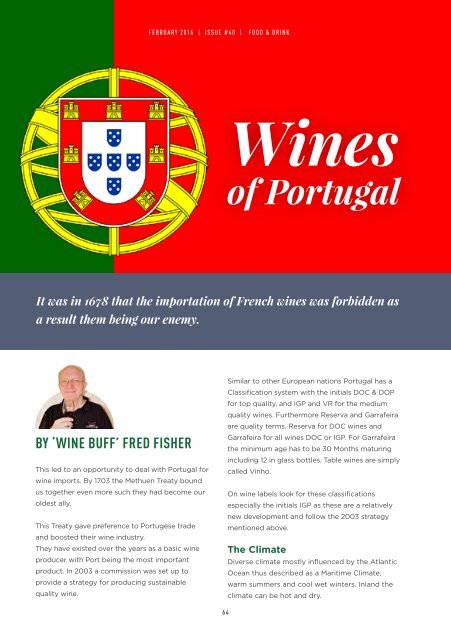Bounce Magazine February 2016
You also want an ePaper? Increase the reach of your titles
YUMPU automatically turns print PDFs into web optimized ePapers that Google loves.
FEBRUARY <strong>2016</strong> | ISSUE #40 |<br />
FOOD & DRINK<br />
Wines<br />
of Portugal<br />
It was in 1678 that the importation of French wines was forbidden as<br />
a result them being our enemy.<br />
BY ‘WINE BUFF’ FRED FISHER<br />
This led to an opportunity to deal with Portugal for<br />
wine imports. By 1703 the Methuen Treaty bound<br />
us together even more such they had become our<br />
oldest ally.<br />
This Treaty gave preference to Portugese trade<br />
and boosted their wine industry.<br />
They have existed over the years as a basic wine<br />
producer with Port being the most important<br />
product. In 2003 a commission was set up to<br />
provide a strategy for producing sustainable<br />
quality wine.<br />
Similar to other European nations Portugal has a<br />
Classification system with the initials DOC & DOP<br />
for top quality, and IGP and VR for the medium<br />
quality wines. Furthermore Reserva and Garrafeira<br />
are quality terms. Reserva for DOC wines and<br />
Garrafeira for all wines DOC or IGP. For Garrafeira<br />
the minimum age has to be 30 Months maturing<br />
including 12 in glass bottles. Table wines are simply<br />
called Vinho.<br />
On wine labels look for these classifications<br />
especially the initials IGP as these are a relatively<br />
new development and follow the 2003 strategy<br />
mentioned above.<br />
The Climate<br />
Diverse climate mostly influenced by the Atlantic<br />
Ocean thus described as a Maritime Climate,<br />
warm summers and cool wet winters. Inland the<br />
climate can be hot and dry.<br />
64


















